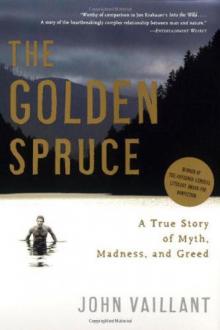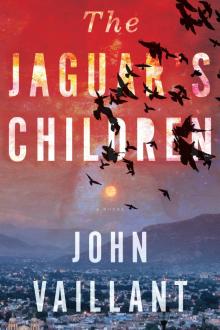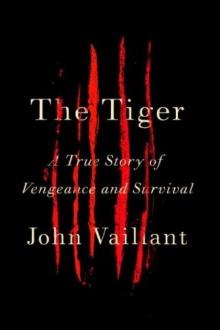- Home
- John Vaillant
The Jaguar's Children Page 24
The Jaguar's Children Read online
Page 24
TH: I got so many it’s like a movie. Here, take a look. Right, that button there.
JB: Wow. He’s beautiful. And big. Jesus, look at those teeth.
TH: Most powerful bite, pound for pound, of any cat. Crush your skull. That’s how they kill, you know—right through the brain.
JB: Amazing. OK, and that’s his collar there.
CW: We watched him for a couple minutes like that.
TH: Which is forever by cat standards.
CW: It was a long time, and we notice that every now and then he’ll wave his nose around by the pipes, especially the one on the left—that one with the elbow there.
TH: He’s scenting something for sure, and I’m saying to Cal, “Oh Lordy, you think that’s what we’re smelling?” And then, my goodness, well, we kind of knew, you know—there’s people in there. Judging by the smell we’re too late, but we have to check it out, so now we got to get Alvin moving.
CW: I didn’t want to dart him if I didn’t have to, so I jumped up and yelled at him and he backed into the thicket. Not far.
TH: Look at this one—you can just see him there. See his eye?
JB: It’s like it’s glowing.
TH: Yeah, they’re spooky that way.
CW: Well, then Ted and me moved in there together, yelling some more, and that got him. He was gone.
TH: But hard to say how far. Onca’s not the kind to attack a man—kid, maybe, but nothing’s normal here, so we kept our guard up, threw some more rocks, but it seemed like he’d cleared out for the time being.
CW: So now I’m saying, “Hola! Anybody there? Qui es aquí!” Well, I know my Spanish is lousy, but there’s nothing coming back. I’m still keeping an eye out for Alvin, and Ted goes in to check that pipe.
TH: I’m telling you, I about lost my breakfast. Smell was that bad. Make your eyes water. So I catch my breath and try knocking on the tank with a rock. Sounded pretty empty but hard to say for sure, so I put my ear to it. Nobody home, but just to be safe, I hold my nose and give a listen to that pipe—
CW: And that’s when he says, “Jesus in Heaven, there’s somebody in there. I can hear him breathing.”
Acknowledgments
This book was a collaborative and often serendipitous process that would never have begun had not my beloved wife, Nora, moved our family to Oaxaca for a year in 2009. I am deeply grateful to her and to the many people we encountered, Mexicano and expat alike, who made us feel welcome in one of the most beautiful, compelling and troubled places I have ever been. The Jaguar’s Children is as much a token of my gratitude to Oaxaca and those who illuminated it as it is the realization of a lifelong dream.
Among those who made Oaxaca especially vivid are Niels Barmeyer, Miguel Batista, Katie Fellman, Aldo González, Carlos Hernández, John Kemner, Steve Lafler, Lapiztola, Cathey López, Mercedes López-Zschaemisch, Serena Makofsky, Linda Martin, Eric Mindling, Jorge Pinzón, Nina Pozzi, Jane Robison, David Sandler, Angélica Vásquez Cruz, Gracia Vásquez Olivera, Heather VerWys and Lauren Waits. Special thanks to Larry Cooper, Kara Hartzler, Saúl Orozco, Melanie Thon and Susana Valdivia for their careful reading, and to David Riker, not only for reading twice, but for his deep understanding of the place and the process.
Foremost among many sources were The Devil’s Highway, by Luis Alberto Urrea, and “Exodus,” by Charles Bowden. The excerpt from W. J. McGee’s “Desert Thirst as Disease” is reproduced courtesy of Journal of the Southwest. For their contributions to my understanding of corn, its history, economy and genetics, I am indebted to Professors Michael Blake, George Haughn, and Andrew Riseman of the University of British Columbia, and to Timothy Wise of Tufts University’s Global Development and Environmental Institute.
Thanks to Richard Grant for sharing “the skeleton key to Mexico,” Janet Chávez Santiago for advice on Zapotec translation, and especially to Annita and the late Tom Harlan for taking me down El Camino del Diablo.
My deepest gratitude goes to Beatrice Monti della Corte von Rezzori and the Santa Maddalena Foundation for granting me the space and time to write a first draft in the most idyllic surroundings I could imagine, and to Sonny Mehta and Louise Dennys for their belief that I belonged there. Ted Hodgkinson, Miguel Syjuco and Evie Wyld were delightful companions in that dreamtime.
I also want to thank my agent, Stuart Krichevsky, for handling my transition to first-person Zapotec fiction so gracefully, and for his unwavering enthusiasm throughout.
Finally, I am indebted to my editors, Louise Dennys and Amanda Lewis at Knopf Canada and Jenna Johnson at Houghton Mifflin Harcourt, for seeing the jaguar in its best light.
Mil gracias, amigos.
About the Author
JOHN VAILLANT’s work has appeared in The New Yorker, the Atlantic, National Geographic, and Outside, among other magazines. His two previous, award-winning books, The Tiger and The Golden Spruce, were international bestsellers. This is his first novel.

 The Golden Spruce: A True Story of Myth, Madness, and Greed
The Golden Spruce: A True Story of Myth, Madness, and Greed The Jaguar's Children
The Jaguar's Children The Tiger: A True Story of Vengeance and Survival
The Tiger: A True Story of Vengeance and Survival The Golden Spruce
The Golden Spruce